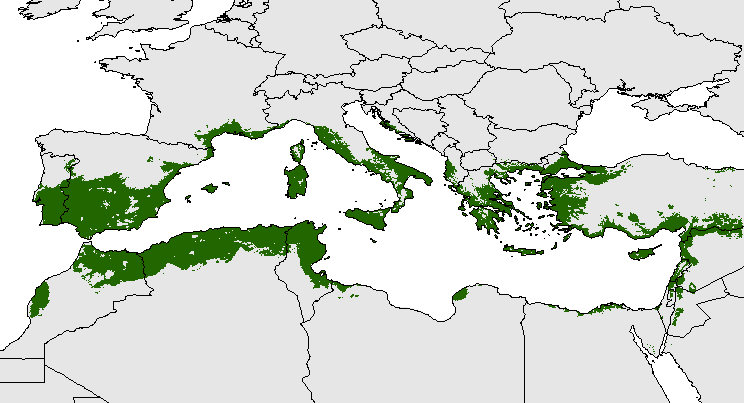|
Mediterranean Biogeographical Region
The Mediterranean Biogeographic Region is the biogeographic region around and including the Mediterranean Sea. The term is defined by the European Environment Agency as applying to the land areas of Europe that border on the Mediterranean Sea, and the corresponding territorial waters. The region is rich in biodiversity and has many endemic species. The term may also be used in the broader sense of all the lands of the Mediterranean Basin, or in the narrow sense of just the Mediterranean Sea. Extent The European Commission defines the Mediterranean Biogeographic Region as consisting of the Mediterranean Sea, Greece, Malta, Cyprus, large parts of Portugal, Spain and Italy, and a smaller part of France. The region includes 20.6% of European Union territory. Climate The region has cool humid winters and hot dry summers. Wladimir Köppen divided his "Cs" mediterranean climate classification into "Csa" with a highest mean monthly temperature over and "Csb" where the mean monthly tem ... [...More Info...] [...Related Items...] OR: [Wikipedia] [Google] [Baidu] |
Monte Arcosu
Monte Arcosu is a mountain in the Sulcis Mountains, Sulcis massif, in southern Sardinia, Italy. It has an elevation of . The mountain has a characteristically truncated cone shape, resulting from the differential erosion which followed its formation during the Variscan orogeny. The massif is formed by a granitic intrusion from the Carboniferous, lying on a Paleozoic schist basement and in turn surmounted by Paleozoic scists. The Variscan orogeny removed the upper schist layer from all the massif's peaks but Monte Arcosu, modelling it and showing the granite along the steep slopes. Sources * Mountains of Sardinia, Arcosu {{Sardinia-geo-stub ... [...More Info...] [...Related Items...] OR: [Wikipedia] [Google] [Baidu] |
Posidonia
''Posidonia'' is a genus of flowering plants. It contains nine species of marine plants ("seagrass"), found in the seas of the Mediterranean and around the south coast of Australia. The APG system (1998) and APG II system (2003) accept this genus as constituting the sole genus in the family Posidoniaceae, which it places in the order Alismatales, in the clade monocots. The AP-Website concludes that the three families Cymodoceaceae, Posidoniaceae and Ruppiaceae form a monophyletic group. Earlier systems classified this genus in the family Potamogetonaceae or in the family Posidoniaceae but belonging to order Zosterales. ''Posidonia oceanica'' has nitrogen fixation capabilities via symbiosis and other species may as well. Species This is a list of species that are contained by the genus: *''Posidonia angustifolia'' Cambridge and Kuo *''Posidonia australis'' Hook.f. South coast of Australia. *''Posidonia coriacea'' Cambridge and Kuo *''Posidonia denhartogii'' Kuo and Cambridge ... [...More Info...] [...Related Items...] OR: [Wikipedia] [Google] [Baidu] |
Phylogeography
Phylogeography is the study of the historical processes that may be responsible for the past to present geographic distributions of genealogical lineages. This is accomplished by considering the geographic distribution of individuals in light of genetics, particularly population genetics. This term was introduced to describe geographically structured genetic signals within and among species. An explicit focus on a species' biogeography/biogeographical past sets phylogeography apart from classical population genetics and phylogenetics. Past events that can be inferred include population expansion, population bottlenecks, vicariance, dispersal, and migration. Recently developed approaches integrating coalescent theory or the genealogical history of alleles and distributional information can more accurately address the relative roles of these different historical forces in shaping current patterns. Development The term phylogeography was first used by John Avise in his 1987 work '' ... [...More Info...] [...Related Items...] OR: [Wikipedia] [Google] [Baidu] |
Middle Miocene
The Middle Miocene is a sub-epoch of the Miocene Epoch made up of two stages: the Langhian and Serravallian stages. The Middle Miocene is preceded by the Early Miocene. The sub-epoch lasted from 15.97 ± 0.05 Ma to 11.608 ± 0.005 Ma (million years ago). During this period, a sharp drop in global temperatures took place. This event is known as the Middle Miocene Climate Transition. For the purpose of establishing European Land Mammal Ages The European Land Mammal Mega Zones (abbreviation: ELMMZ, more commonly known as European land mammal ages or ELMA) are zones in rock layers that have a specific assemblage of fossils (biozones) based on occurrences of fossil assemblages of Europe ... this sub-epoch is equivalent to the Astaracian age. External links GeoWhen Database - Middle Miocene .02 02 * * {{geochronology-stub ... [...More Info...] [...Related Items...] OR: [Wikipedia] [Google] [Baidu] |

